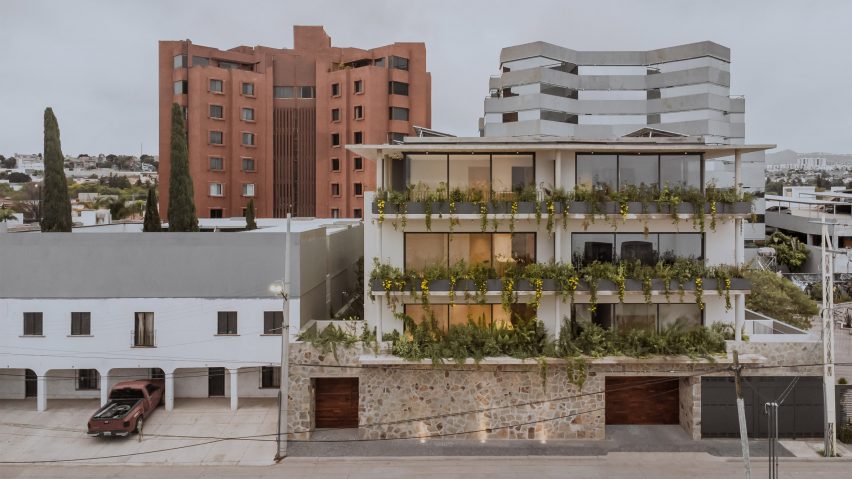Cuartopiso and Barragán Arquitectos have completed an all-electric, twelve-unit apartment complex with wide balconies overlooking the street in Santiago de Querétaro, Mexico.
Local agency Cuartopiso partnered with Barragán Arquitectos, a Mexico City-based studio founded by the nephew of Mexican architect Luis Barragán, to build Hacienda Santa Bárbara 107, which measures 978 square metres (10,527 square feet) and was completed in 2023.
The complex is located on a vacant lot in the middle of the growing metropolitan area of Querétaro, and the design works to activate the property and its residents with easy pedestrian and bicycle access around the old part of the city.
"The building evokes a series of spaces that convey the experience of living in a place where natural materials, architecture and the neighborhood contribute to our happiness," the team told Dezeen.
"Our project brought life to a once quiet street and utilized an urban void in a way that allows for more sustainable and connected lifestyles to occur," the team said.
The building – which takes up about 65 per cent of the parcel – is placed at the centre of the lot and maximizes views, natural light and cross ventilation, as well as creating a direct relationship with the surrounding city through deep balconies on the top three levels of the four-storey design.
The ground level is walled off from the street but each of the twelve apartments are corner units, which the studio said is "a simple and rare luxury that substantially improves the quality of the spaces and makes it possible to separate public and private life".
The concrete floor slabs push past the perimeter of the enclosed space to create planted terraces, which bring rhythm, light, and aperture to the building.
"These exterior spaces work as an extension of the living room and at the same time include a green barrier that allows privacy to be kept," the team said.
In terms of materials, the team utilized regional limestone finishes, terrazzo and marble floors, and wood, concrete and ironwork elements.
"We made an extra effort to source materials locally, from bricks to finishes, not only to reduce carbon footprint, but also because we believe that architecture dialogs to its context through materiality."
"With these materials we respect the architecture of the area, we value nature and we recover artisan manufacturing."
The exterior walls are constructed with a double layer of hollow clay bricks that mitigate the internal temperature.
The all-electric design is fed by solar panels on the roof, which is divided into designated sections for an array for each apartment, as well as one for the elevator and common area lighting.
The roof also serves as a rain collection system that filters water into the subsoil at the basement level.
"Most importantly, the building's greatest environmental feature is its location," the team said, referencing the efforts to re-densify the city and reduce vehicular emissions in Querétaro.
Luis Barragán Rivera founded Barragán Arquitectos in 1991 after working in his uncle's workshop. The studio works to prioritize the ideal "less is more," in its design, which is evident in many of Luis Barragán's works, such as his 1976 design of Casa Gilardi.
Other recent projects in Querétaro include a basalt-clad residence by Reims 502.
The photography is by Ariadna Polo and Lost Immigrants.
Project credits:
Architects: Cuartopiso, Barragán Arquitectos
Architects in charge: Juan Pablo González de Cossio, Luis Barragán Rivera
Landscaping: matorral
Communication: area colectiva

